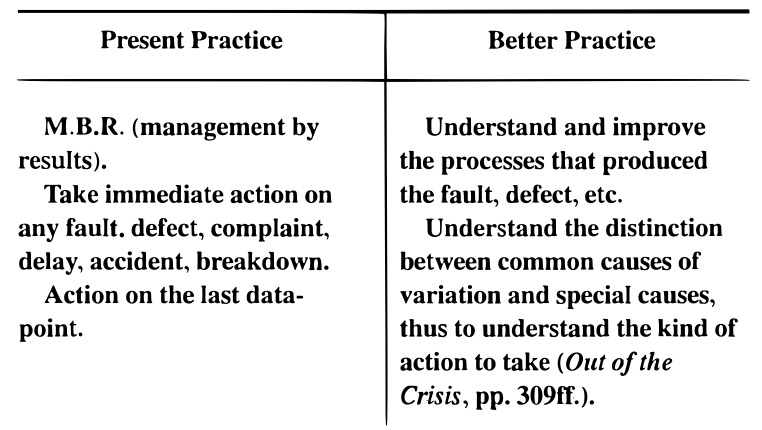Mini Case Study: The Case of the Withheld Sales
How One Faulty Practice Begets Another
THE AIM for this brief post is to share a mini case study about a Canadian auto distributor, Kia Canada, and the trouble they are about to find themselves in as a result of their using the common or prevailing practices of management Dr. Deming warned us about decades ago, particularly Management by Results, and the unknown and unknowable consequences that will follow.
While tempting to blame entirely on leadership, this is also an example of a component responding rationally to the system they are within—a cautionary tale with many lessons.
Our source is a December 19, 2023 CBC News story: Is your new car on a storage compound? Inside Kia's scheme to deliberately withhold deliveries
Just the Facts
In brief: Kia Canada, having already hit their annual sales target of 84,000 vehicles, is planning to deliberately withhold the delivery of any further inventory to long-waiting customers out of fear of being penalized by Kia HQ in Korea with a reduced marketing budget for 2024, something that is probably codified into their budgeting practices when a region exceeds targets.
In a leaked video with Ontario dealer reps, Kia Regional Manager, Vince Capicotto, said:
"With the global slow down, Kia Canada wants to control wholesale and retail performance in 2023 to not show high over-achievement," he said.
"There's a high risk with over performance that Kia headquarters will not provide Kia Canada resources necessary in our budget for 2024 to have a successful year if we over perform for the balance of 2023 at too high a rate."
As a result, paying customers will wait longer for their cars, dealerships won’t realize the commensurate revenue, sales won’t receive commissions which they are heavily reliant upon, and employee morale takes a hit. Ain’t nobody happy about the situation, especially right before Christmas.
An Unusual Strategy?
In the article, an automotive analyst is calling Kia Canada’s ploy “an unusual strategy” because it works opposite to expectations, ie. making the last quarter look unexceptional instead of ginning things up to make them look better.
In either case, this is a phenomena that will be immediately familiar to Deming practitioners as a classic example of tampering using the faulty practice of Management by Results, and to many as a variation on the theme of “Use It Or Lose It” budgeting:
In this case, Kia Canada is responding rationally to the budgeting system Kia HQ in Korea has established: sales in excess of target incur a penalty on future marketing budgets, ergo throttle sales downward to make the year look good, but not exceptional, so as to preserve funding irrespective of the system impacts this will have for customers, dealerships, sales, servicing, and employees. A classic example of one faulty practice begetting another.
Consequences
While senior leadership might see this as an unavoidable and necessary move, and may have actually considered that the visible benefits outweigh the predicted losses, they aren’t likely considering the unknown and unknowable consequences that accrue and cannot be easily measured but must be managed for, anyway. As Deming explains in Out of the Crisis:
5. Running a company on visible figures alone (counting the money). One can not be successful on visible figures alone. Now of course, visible figures are important. There is payroll to meet, vendors to pay, taxes to pay; amortization, pension funds, and contingency funds to meet. But he that would run his company on visible figures alone will in time have neither company nor figures.
Actually, the most important figures that one needs for management are unknown or unknowable (Lloyd S. Nelson, p. 20), but successful management must nevertheless take account of them.
Examples:
1. The multiplying effect on sales that comes from a happy customer, and the opposite effect from an unhappy customer. The happy customer that comes back for more is worth 10 prospects. He comes without advertising or persuasion, and he may even bring in a friend.
It pays to keep the customers satisfied: if a car owner likes his car, he’s apt to buy four more cars of the same make over the following twelve years, says Technical Assistance Research Program, a Washington consulting firm that specializes in consumer behavior. The customer is also likely to spread the good news to eight other people. But woe to the car company that delivers a shoddy product. An angry car buyer will tell his troubles to an average of sixteen people. (Car and Driver. August 1983, p. 33.)
- Deming, W. Edwards. Out of the Crisis (The MIT Press) (pp. 121-122).
In other words, what Kia Canada leadership believes they can “save” in a future marketing budget could be wiped out entirely (and then some) by the ill-will they will generate among dealerships, their staff and customers. If we imagine that a typical family may have an immediate cohort of say, 25 close friends and family members who will all hear about their poor experience buying a Kia, how many lost sales will this cause? What will be the impact to Kia Canada and Kia HQ in Korea as a result? How about among staff and their families?
No need to imagine too deeply, it’s already happening:
One employee said some of his customers are ditching the company after learning about additional delays to receive their cars…
[One Ontario Kia manager] … says he's already had customers who've paid a deposit walk away when they learned of the additional delays.
"Last week alone we lost three sold orders," he said, shaking his head.
"Now we're going to come up with some boneheaded idea that we're just going to … leave them all rotting [on compounds] until the new year," he said. "Does that make sense? That is the worst."
He said the plan to deliberately withhold cars from sale may be the final straw he's considering leaving Kia in the new year.
These are, despite outward appearances to the contrary, entirely natural and foreseeable outcomes of the prevailing style of management that focuses on managing parts rather than wholes. Were leadership to have a broader, system-based view, they would be unlikely to play games at the expense of customers in the hopes of securing funding for future years and favour a much more long-term strategy where everyone wins.
Other Faulty Practices
Some other observations from this case as viewed through a Deming lens:
The liberal use of fear pervades the entire story. Deming observed that fear invites wrong figures, and Kia Canada delivered on this prediction quite handily by concocting a plan to hide their true sales figures out of fear of losing their budget, and obviously fear speaking to Kia HQ plainly about it. As a result, dealerships now fear losing customers and employees, while sales fear losing their commissions, and everyone fears what the forecasted tough Canadian economy will bring in 2024.
The liberal use of incentives that causes commensurate distortions in the system, eg. sales commissions — we’ve covered this in our Aug. 25/21 newsletter, Salaries Over Commissions.
Managing the entire operation as individual profit centres rather than a system with the consequence that everybody loses.
Lack of constancy of purpose for the future and plenty of short-term thinking to go around. Again: Kia Canada is acting rationally to the system they are within as established by Kia HQ in Korea. They are incentivized to act this way, despite the detriment of their customers.
Rx? It Begins at the TOP
My suggestions to top-management are the following:
Immediately reverse the decision to withhold inventory and ship all available cars to customers, delivering them personally to their homes if possible. Waive all usual delivery charges and inspection fees, offer free oil changes for the next year. For customers who are waiting over a year to replace an aging vehicle, offer free servicing to tide them over until delivery. Update all customers regularly without having to be asked. The aim is to turn your borderline hostile customers back into enthusiastic supporters by respecting them, first.
Find some courage and get into tough negotiations with Kia HQ about their budgeting practices with the aim to disconnect them from sales figures and more toward local market conditions. Suggest experimenting with a system of “drip funding” to establish a baseline understanding of how sales varies in response to promotions. Explain how this is necessary if the aim is to be competitive and remain in business in Canada for the long-haul.
Cease incentivizing sales with commissions; pay them a base salary plus an average of past commissions to start. Reward seniority and improvements made to the system by cooperating with other parts of the dealership. For example, in many dealerships sales and service are two isolated departments, yet both are dependent on the other for future work. START BEHAVING THAT WAY.
LISTEN TO YOUR DEALERSHIPS, SALES, AND EMPLOYEES. They are telling you about all the canaries in the coalmine for your business. Don’t wait until you lose employees and customers to start turning things around: the hard work begins now.
LEARN A NEW THEORY OF MANAGEMENT AIMED AT IMPROVING QUALITY. Your service is sub-par in the eyes of your customers, dealership owners, and employees. This is a direct consequence of the prevailing management theory, and can be repaired by learning what to do instead, ie. by operating the business as a system. Start by familiarizing yourselves with The New Competencies of management and the management theory of Dr. W.E. Deming.
My suggestions for dealerships and their employees is to learn some of this theory for themselves and to agitate for your leadership to do the same. Work together to solve this problem as a team rather than isolated parts.
Reflection Questions
Consider the case study of Kia Canada: What else do you see happening when viewed through the lens of Deming’s management theory? Have you observed similar situations in your organization or in others? What commensurate behaviours did it drive, good or bad? How were they remedied, if at all? What would you suggest to Kia Canada’s leadership?
Consider the unknown and unknowable effects of one satisfied vs. dissatisfied customer: what else could Kia Canada and their dealership owners do to redirect their energies toward the customer in the face of shortages and tough economic conditions?
When I worked at Microsoft Canada, I saw a similar reaction to the perverse incentives between Kia HQ and Kia Canada emerge among my more senior colleagues who actively avoided promotions despite increases in perks and pay. Why? Because their earnings after taxes would have them basically standing still while their workload increased.
This chafed management who were all measured on how many consultants they oversaw, which would increase their budget, prestige, and promotion opportunities, incentivizing them to back-fill their team with new hires, who would then be promoted and back-filled, etc. Round and round — irrespective of need, which also made them good targets for layoffs.
What stories do you have?




This is an outstanding example of unintended consequences resulting in a broken system, Chris. I have already shared your piece with many people. Thank you!